window FIAT DUCATO 2010 Owner handbook (in English)
[x] Cancel search | Manufacturer: FIAT, Model Year: 2010, Model line: DUCATO, Model: FIAT DUCATO 2010Pages: 286, PDF Size: 12.53 MB
Page 144 of 286
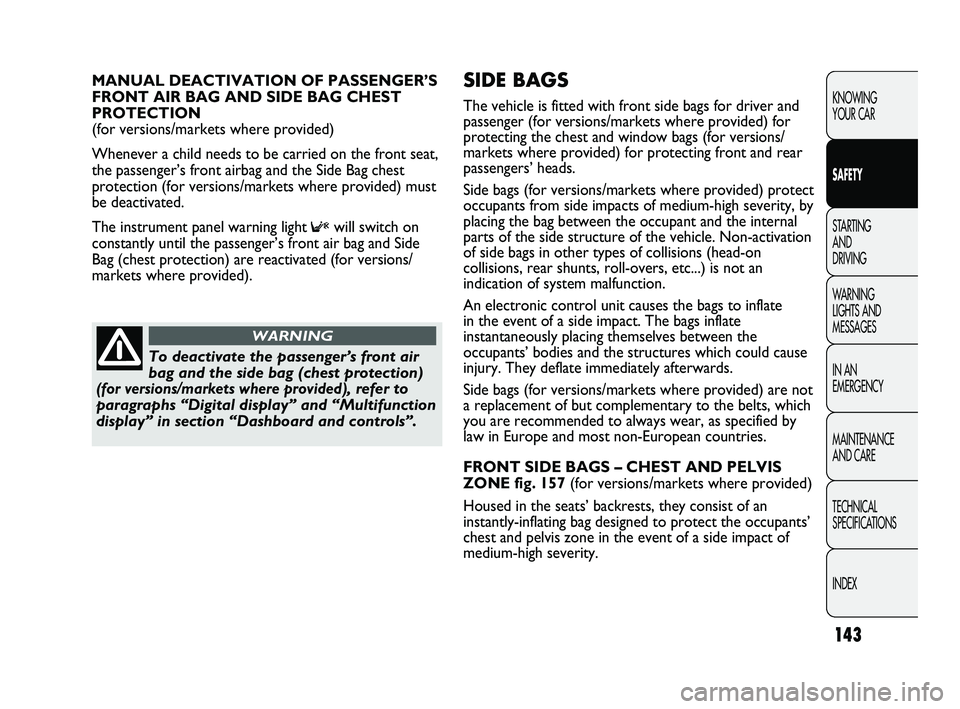
143
KNOWING
YOUR CAR
SAFETY
STARTING
AND
DRIVING
WARNING
LIGHTS AND
MESSAGES
IN AN
EMERGENCY
MAINTENANCE
AND CARE
TECHNICAL
SPECIFICATIONS
INDEX
SIDE BAGS
The vehicle is fitted with front side bags for driver and
passenger (for versions/markets where provided) for
protecting the chest and window bags (for versions/
markets where provided) for protecting front and rear
passengers’ heads.
Side bags (for versions/markets where provided) protect
occupants from side impacts of medium-high severity, by
placing the bag between the occupant and the internal
parts of the side structure of the vehicle. Non-activation
of side bags in other types of collisions (head-on
collisions, rear shunts, roll-overs, etc...) is not an
indication of system malfunction.
An electronic control unit causes the bags to inflate
in the event of a side impact. The bags inflate
instantaneously placing themselves between the
occupants’ bodies and the structures which could cause
injury. They deflate immediately afterwards.
Side bags (for versions/markets where provided) are not
a replacement of but complementary to the belts, which
you are recommended to always wear, as specified by
law in Europe and most non-European countries.
FRONT SIDE BAGS – CHEST AND PELVIS
ZONE fig. 157 (for versions/markets where provided)
Housed in the seats’ backrests, they consist of an
instantly-inflating bag designed to protect the occupants’
chest and pelvis zone in the event of a side impact of
medium-high severity. MANUAL DEACTIVATION OF PASSENGER’S
FRONT AIR BAG AND SIDE BAG CHEST
PROTECTION
(for versions/markets where provided)
Whenever a child needs to be carried on the front seat,
the passenger’s front airbag and the Side Bag chest
protection (for versions/markets where provided) must
be deactivated.
The instrument panel warning light
Fwill switch on
constantly until the passenger’s front air bag and Side
Bag (chest protection) are reactivated (for versions/
markets where provided).
To deactivate the passenger’s front air
bag and the side bag (chest protection)
(for versions/markets where provided), refer to
paragraphs “Digital display” and “Multifunction
display” in section “Dashboard and controls”.
WARNING
129-146 DUCATO LUM EN 7ed 6/21/10 2:12 PM Page 143
Page 145 of 286
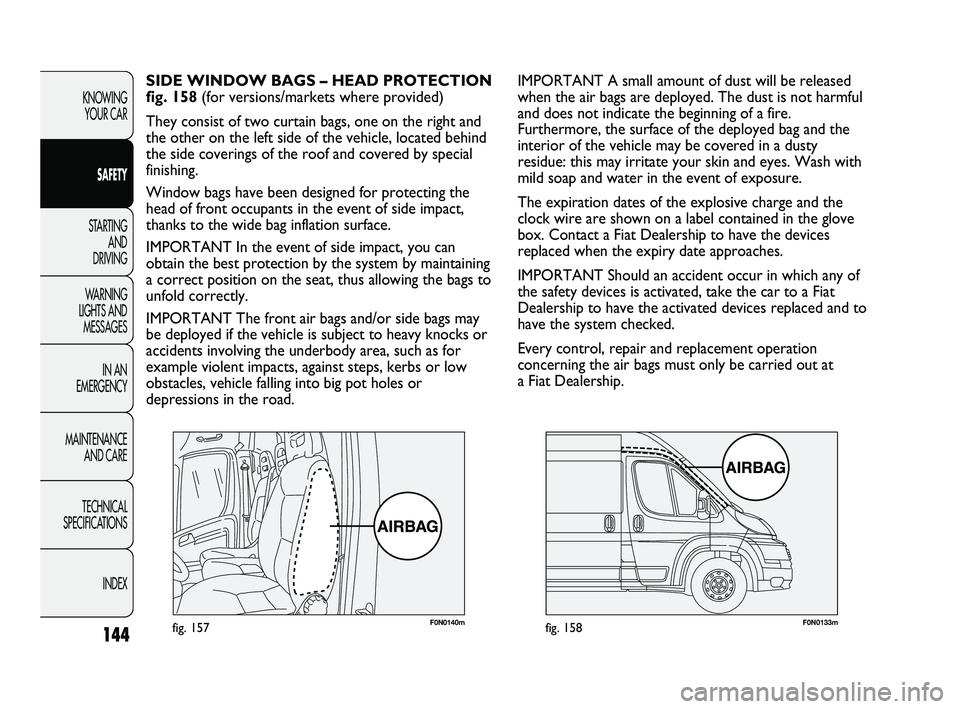
144
KNOWING
YOUR CAR
SAFETY
STARTING
AND
DRIVING
WARNING
LIGHTS AND
MESSAGES
IN AN
EMERGENCY
MAINTENANCE
AND CARE
TECHNICAL
SPECIFICATIONS
INDEX
F0N0140mfig. 157F0N0133mfig. 158
IMPORTANT A small amount of dust will be released
when the air bags are deployed. The dust is not harmful
and does not indicate the beginning of a fire.
Furthermore, the surface of the deployed bag and the
interior of the vehicle may be covered in a dusty
residue: this may irritate your skin and eyes. Wash with
mild soap and water in the event of exposure.
The expiration dates of the explosive charge and the
clock wire are shown on a label contained in the glove
box. Contact a Fiat Dealership to have the devices
replaced when the expiry date approaches.
IMPORTANT Should an accident occur in which any of
the safety devices is activated, take the car to a Fiat
Dealership to have the activated devices replaced and to
have the system checked.
Every control, repair and replacement operation
concerning the air bags must only be carried out at
a Fiat Dealership. SIDE WINDOW BAGS – HEAD PROTECTION
fig. 158 (for versions/markets where provided)
They consist of two curtain bags, one on the right and
the other on the left side of the vehicle, located behind
the side coverings of the roof and covered by special
finishing.
Window bags have been designed for protecting the
head of front occupants in the event of side impact,
thanks to the wide bag inflation surface.
IMPORTANT In the event of side impact, you can
obtain the best protection by the system by maintaining
a correct position on the seat, thus allowing the bags to
unfold correctly.
IMPORTANT The front air bags and/or side bags may
be deployed if the vehicle is subject to heavy knocks or
accidents involving the underbody area, such as for
example violent impacts, against steps, kerbs or low
obstacles, vehicle falling into big pot holes or
depressions in the road.
129-146 DUCATO LUM EN 7ed 6/21/10 2:12 PM Page 144
Page 146 of 286
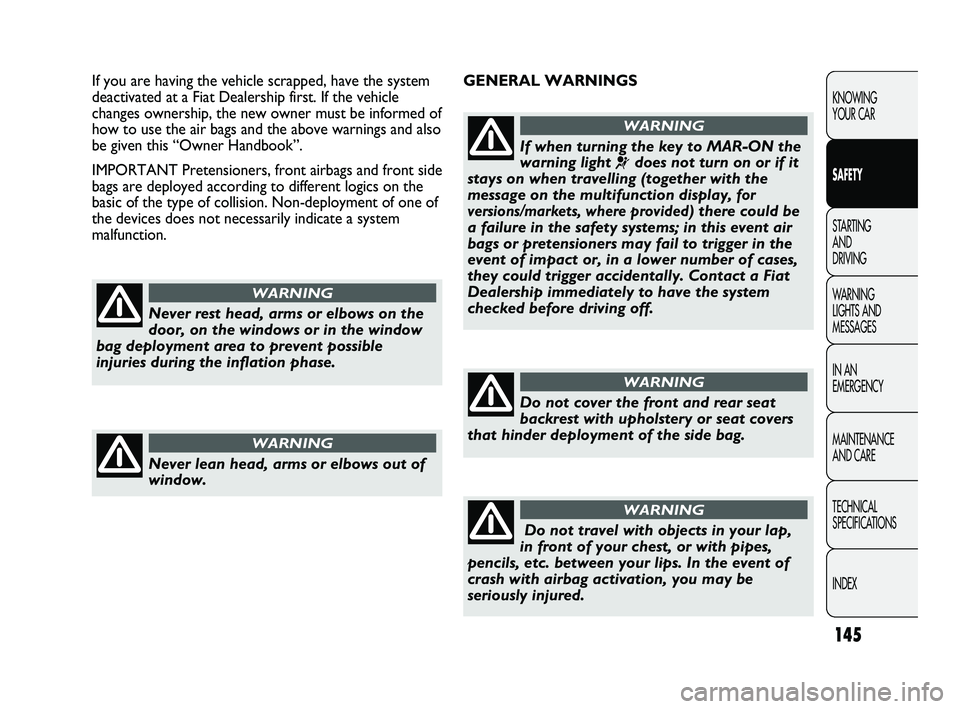
145
KNOWING
YOUR CAR
SAFETY
STARTING
AND
DRIVING
WARNING
LIGHTS AND
MESSAGES
IN AN
EMERGENCY
MAINTENANCE
AND CARE
TECHNICAL
SPECIFICATIONS
INDEX
GENERAL WARNINGS If you are having the vehicle scrapped, have the system
deactivated at a Fiat Dealership first. If the vehicle
changes ownership, the new owner must be informed of
how to use the air bags and the above warnings and also
be given this “Owner Handbook”.
IMPORTANT Pretensioners, front airbags and front side
bags are deployed according to different logics on the
basic of the type of collision. Non-deployment of one of
the devices does not necessarily indicate a system
malfunction.
Never rest head, arms or elbows on the
door, on the windows or in the window
bag deployment area to prevent possible
injuries during the inflation phase.
WARNING
Never lean head, arms or elbows out of
window.
WARNING
If when turning the key to MAR-ON the
warning light
¬does not turn on or if it
stays on when travelling (together with the
message on the multifunction display,
for
versions/markets, where provided
) there could be
a failure in the safety systems; in this event air
bags or pretensioners may fail to trigger in the
event of impact or, in a lower number of cases,
they could trigger accidentally. Contact a Fiat
Dealership immediately to have the system
checked before driving off.
WARNING
Do not cover the front and rear seat
backrest with upholstery or seat covers
that hinder deployment of the side bag.
WARNING
Do not travel with objects in your lap,
in front of your chest, or with pipes,
pencils, etc. between your lips. In the event of
crash with airbag activation, you may be
seriously injured.
WARNING
129-146 DUCATO LUM EN 7ed 6/21/10 2:12 PM Page 145
Page 154 of 286
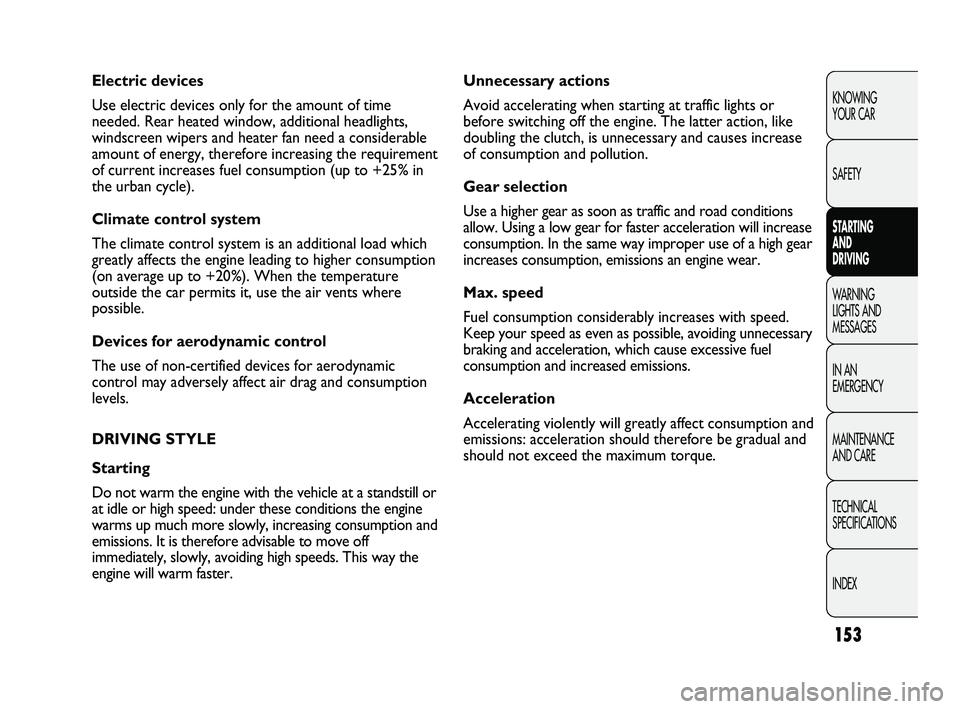
153
KNOWING
YOUR CAR
SAFETY
STARTING
AND
DRIVING
WARNING
LIGHTS AND
MESSAGES
IN AN
EMERGENCY
MAINTENANCE
AND CARE
TECHNICAL
SPECIFICATIONS
INDEX
Unnecessary actions
Avoid accelerating when starting at traffic lights or
before switching off the engine. The latter action, like
doubling the clutch, is unnecessary and causes increase
of consumption and pollution.
Gear selection
Use a higher gear as soon as traffic and road conditions
allow. Using a low gear for faster acceleration will increase
consumption. In the same way improper use of a high gear
increases consumption, emissions an engine wear.
Max. speed
Fuel consumption considerably increases with speed.
Keep your speed as even as possible, avoiding unnecessary
braking and acceleration, which cause excessive fuel
consumption and increased emissions.
Acceleration
Accelerating violently will greatly affect consumption and
emissions: acceleration should therefore be gradual and
should not exceed the maximum torque. Electric devices
Use electric devices only for the amount of time
needed. Rear heated window, additional headlights,
windscreen wipers and heater fan need a considerable
amount of energy, therefore increasing the requirement
of current increases fuel consumption (up to +25% in
the urban cycle).
Climate control system
The climate control system is an additional load which
greatly affects the engine leading to higher consumption
(on average up to +20%). When the temperature
outside the car permits it, use the air vents where
possible.
Devices for aerodynamic control
The use of non-certified devices for aerodynamic
control may adversely affect air drag and consumption
levels.
DRIVING STYLE
Starting
Do not warm the engine with the vehicle at a standstill or
at idle or high speed: under these conditions the engine
warms up much more slowly, increasing consumption and
emissions. It is therefore advisable to move off
immediately, slowly, avoiding high speeds. This way the
engine will warm faster.
147-160 DUCATO LUM EN 7ed 6/21/10 2:13 PM Page 153
Page 161 of 286
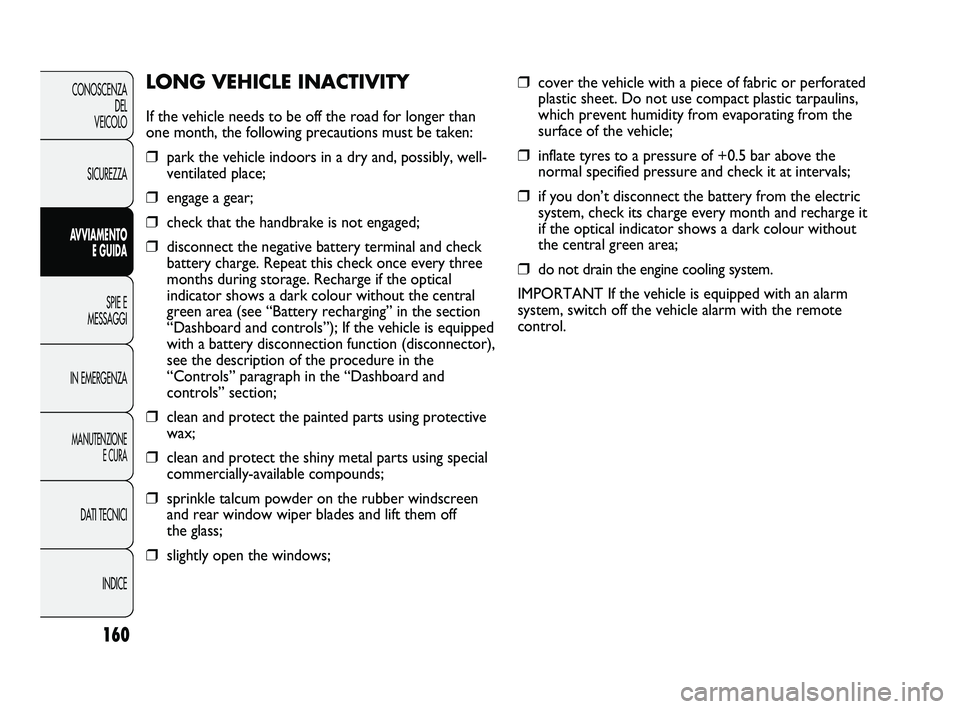
❒cover the vehicle with a piece of fabric or perforated
plastic sheet. Do not use compact plastic tarpaulins,
which prevent humidity from evaporating from the
surface of the vehicle;
❒inflate tyres to a pressure of +0.5 bar above the
normal specified pressure and check it at intervals;
❒if you don’t disconnect the battery from the electric
system, check its charge every month and recharge it
if the optical indicator shows a dark colour without
the central green area;
❒do not drain the engine cooling system.
IMPORTANT If the vehicle is equipped with an alarm
system, switch off the vehicle alarm with the remote
control.
LONG VEHICLE INACTIVITY
If the vehicle needs to be off the road for longer than
one month, the following precautions must be taken:
❒park the vehicle indoors in a dry and, possibly, well-
ventilated place;
❒engage a gear;
❒check that the handbrake is not engaged;
❒disconnect the negative battery terminal and check
battery charge. Repeat this check once every three
months during storage. Recharge if the optical
indicator shows a dark colour without the central
green area (see “Battery recharging” in the section
“Dashboard and controls”); If the vehicle is equipped
with a battery disconnection function (disconnector),
see the description of the procedure in the
“Controls” paragraph in the “Dashboard and
controls” section;
❒clean and protect the painted parts using protective
wax;
❒clean and protect the shiny metal parts using special
commercially-available compounds;
❒sprinkle talcum powder on the rubber windscreen
and rear window wiper blades and lift them off
the glass;
❒slightly open the windows;
160
CONOSCENZA
DEL
VEICOLO
SICUREZZA
AVVIAMENTO
E GUIDA
SPIE E
MESSAGGI
IN EMERGENZA
MANUTENZIONE
E CURA
DATI TECNICI
INDICE
147-160 DUCATO LUM EN 7ed 6/21/10 2:13 PM Page 160
Page 179 of 286
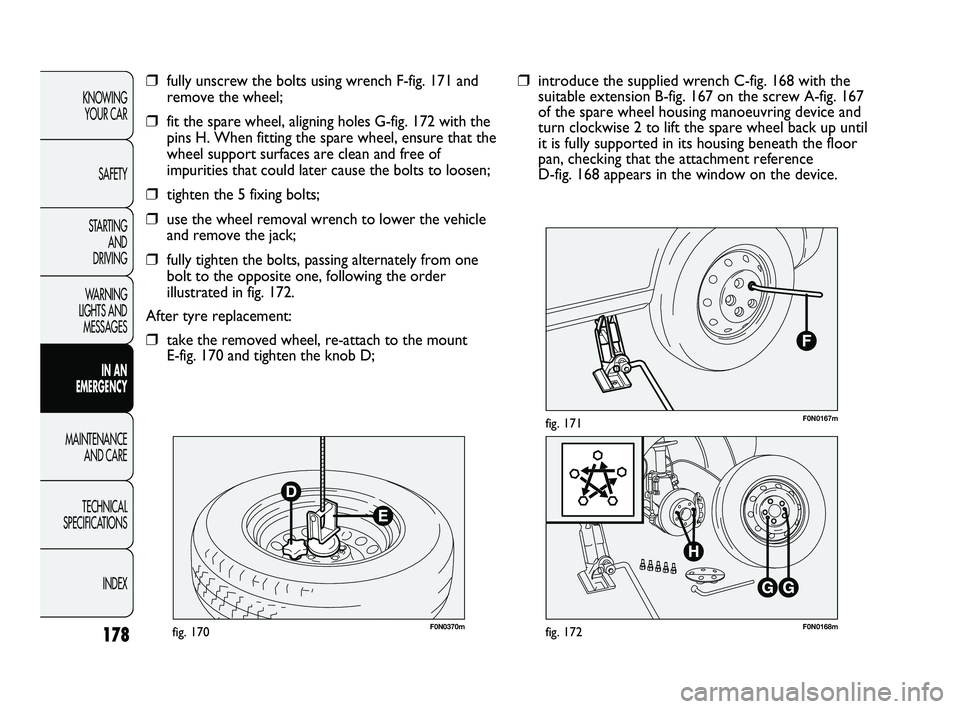
178
KNOWING
YOUR CAR
SAFETY
STARTING
AND
DRIVING
WARNING
LIGHTS AND
MESSAGES
IN AN
EMERGENCY
MAINTENANCE
AND CARE
TECHNICAL
SPECIFICATIONS
INDEX
F0N0370mfig. 170F0N0168mfig. 172
F0N0167mfig. 171
❒introduce the supplied wrench C-fig. 168 with the
suitable extension B-fig. 167 on the screw A-fig. 167
of the spare wheel housing manoeuvring device and
turn clockwise 2 to lift the spare wheel back up until
it is fully supported in its housing beneath the floor
pan, checking that the attachment reference
D-fig. 168 appears in the window on the device.❒fully unscrew the bolts using wrench F-fig. 171 and
remove the wheel;
❒fit the spare wheel, aligning holes G-fig. 172 with the
pins H. When fitting the spare wheel, ensure that the
wheel support surfaces are clean and free of
impurities that could later cause the bolts to loosen;
❒tighten the 5 fixing bolts;
❒use the wheel removal wrench to lower the vehicle
and remove the jack;
❒fully tighten the bolts, passing alternately from one
bolt to the opposite one, following the order
illustrated in fig. 172.
After tyre replacement:
❒take the removed wheel, re-attach to the mount
E-fig. 170 and tighten the knob D;
173-206 DUCATO LUM EN 8ed 27-10-2010 15:45 Pagina 178
Page 181 of 286
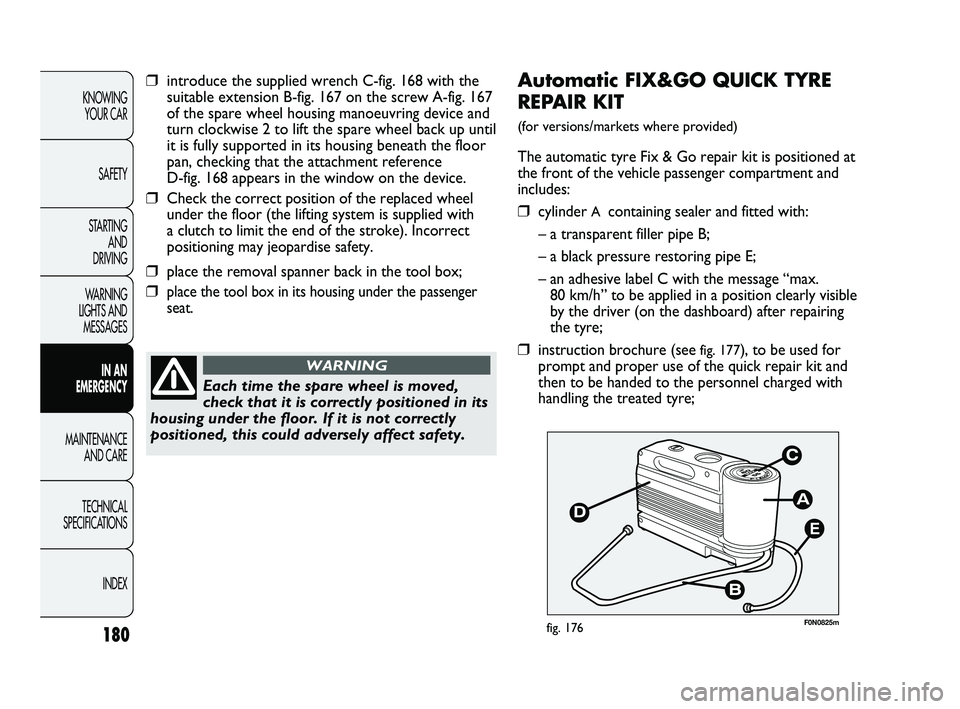
180
KNOWING
YOUR CAR
SAFETY
STARTING
AND
DRIVING
WARNING
LIGHTS AND
MESSAGES
IN AN
EMERGENCY
MAINTENANCE
AND CARE
TECHNICAL
SPECIFICATIONS
INDEX
E
F0N0825mfig. 176
Automatic FIX&GO QUICK TYRE
REPAIR KIT
(for versions/markets where provided)
The automatic tyre Fix & Go repair kit is positioned at
the front of the vehicle passenger compartment and
includes:
❒cylinder A containing sealer and fitted with:
– a transparent filler pipe B;
– a black pressure restoring pipe E;
– an adhesive label C with the message “max.
80 km/h” to be applied in a position clearly visible
by the driver (on the dashboard) after repairing
the tyre;
❒instruction brochure (see fig. 177), to be used for
prompt and proper use of the quick repair kit and
then to be handed to the personnel charged with
handling the treated tyre;
Each time the spare wheel is moved,
check that it is correctly positioned in its
housing under the floor. If it is not correctly
positioned, this could adversely affect safety.
WARNING
❒introduce the supplied wrench C-fig. 168 with the
suitable extension B-fig. 167 on the screw A-fig. 167
of the spare wheel housing manoeuvring device and
turn clockwise 2 to lift the spare wheel back up until
it is fully supported in its housing beneath the floor
pan, checking that the attachment reference
D-fig. 168 appears in the window on the device.
❒Check the correct position of the replaced wheel
under the floor (the lifting system is supplied with
a clutch to limit the end of the stroke). Incorrect
positioning may jeopardise safety.
❒place the removal spanner back in the tool box;
❒place the tool box in its housing under the passenger
seat.
173-206 DUCATO LUM EN 8ed 27-10-2010 15:45 Pagina 180
Page 202 of 286
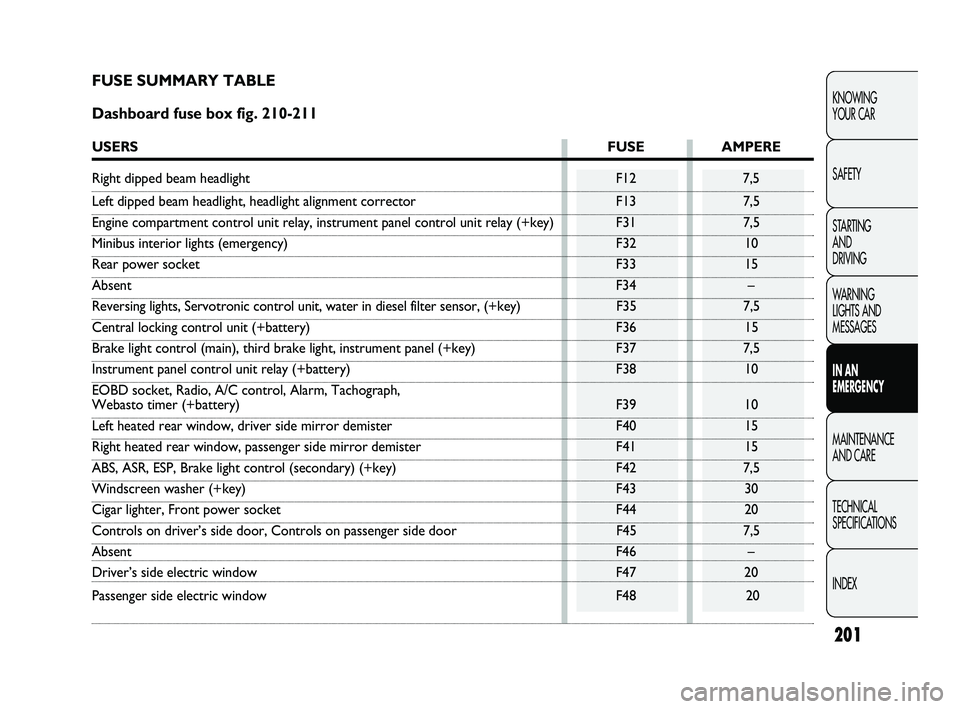
201
KNOWING
YOUR CAR
SAFETY
STARTING
AND
DRIVING
WARNING
LIGHTS AND
MESSAGES
IN AN
EMERGENCY
MAINTENANCE
AND CARE
TECHNICAL
SPECIFICATIONS
INDEX
FUSE SUMMARY TABLE
Dashboard fuse box fig. 210-211
USERSFUSE AMPERE
Right dipped beam headlight F12 7,5
Left dipped beam headlight, headlight alignment corrector F13 7,5
Engine compartment control unit relay, instrument panel control unit relay (+key) F31 7,5
Minibus interior lights (emergency) F32 10
Rear power socket F33 15
AbsentF34 –
Reversing lights, Servotronic control unit, water in diesel filter sensor, (+key) F35 7,5
Central locking control unit (+battery) F36 15
Brake light control (main), third brake light, instrument panel (+key) F37 7,5
Instrument panel control unit relay (+battery) F38 10
EOBD socket, Radio, A/C control, Alarm, Tachograph,
Webasto timer (+battery) F39 10
Left heated rear window, driver side mirror demister F40 15
Right heated rear window, passenger side mirror demister F41 15
ABS, ASR, ESP, Brake light control (secondary) (+key) F42 7,5
Windscreen washer (+key) F43 30
Cigar lighter, Front power socket F44 20
Controls on driver’s side door, Controls on passenger side door F45 7,5
AbsentF46 –
Driver’s side electric window F47 20
Passenger side electric window F48 20
173-206 DUCATO LUM EN 8ed 27-10-2010 15:45 Pagina 201
Page 203 of 286
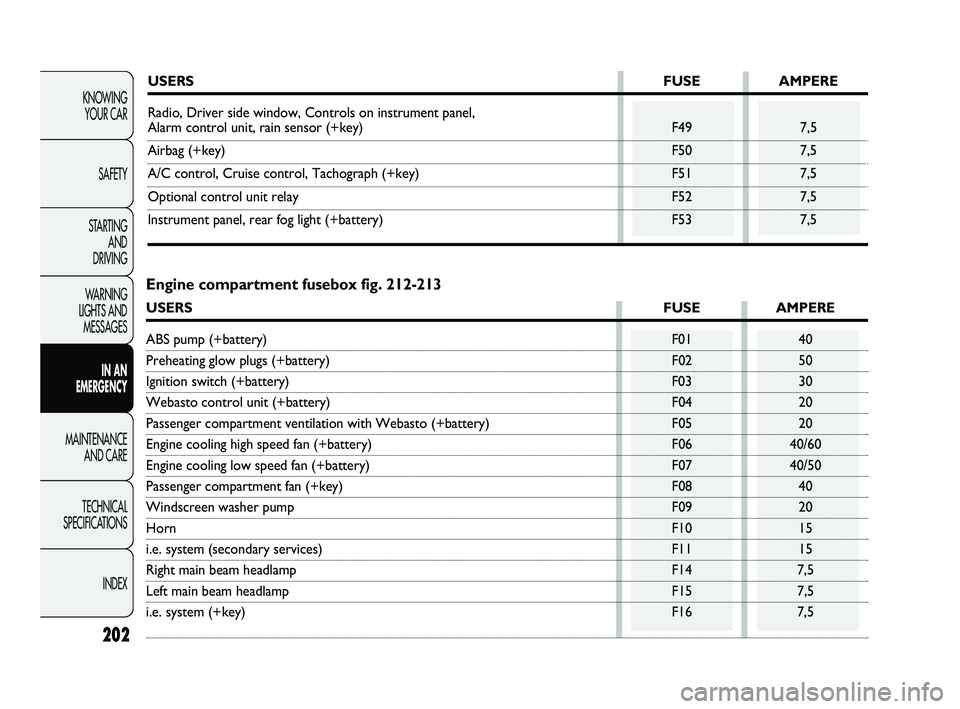
202
KNOWING
YOUR CAR
SAFETY
STARTING
AND
DRIVING
WARNING
LIGHTS AND
MESSAGES
IN AN
EMERGENCY
MAINTENANCE
AND CARE
TECHNICAL
SPECIFICATIONS
INDEX
USERSFUSE AMPERE
Radio, Driver side window, Controls on instrument panel,
Alarm control unit, rain sensor (+key) F49 7,5
Airbag (+key) F50 7,5
A/C control, Cruise control, Tachograph (+key) F51 7,5
Optional control unit relay F52 7,5
Instrument panel, rear fog light (+battery) F53 7,5
Engine compartment fusebox fig. 212-213
USERSFUSE AMPERE
ABS pump (+battery) F01 40
Preheating glow plugs (+battery) F02 50
Ignition switch (+battery) F03 30
Webasto control unit (+battery) F04 20
Passenger compartment ventilation with Webasto (+battery) F05 20
Engine cooling high speed fan (+battery) F06 40/60
Engine cooling low speed fan (+battery) F07 40/50
Passenger compartment fan (+key) F08 40
Windscreen washer pump F09 20
HornF10 15
i.e. system (secondary services) F11 15
Right main beam headlamp F14 7,5
Left main beam headlamp F15 7,5
i.e. system (+key) F16 7,5
173-206 DUCATO LUM EN 8ed 27-10-2010 15:45 Pagina 202
Page 213 of 286
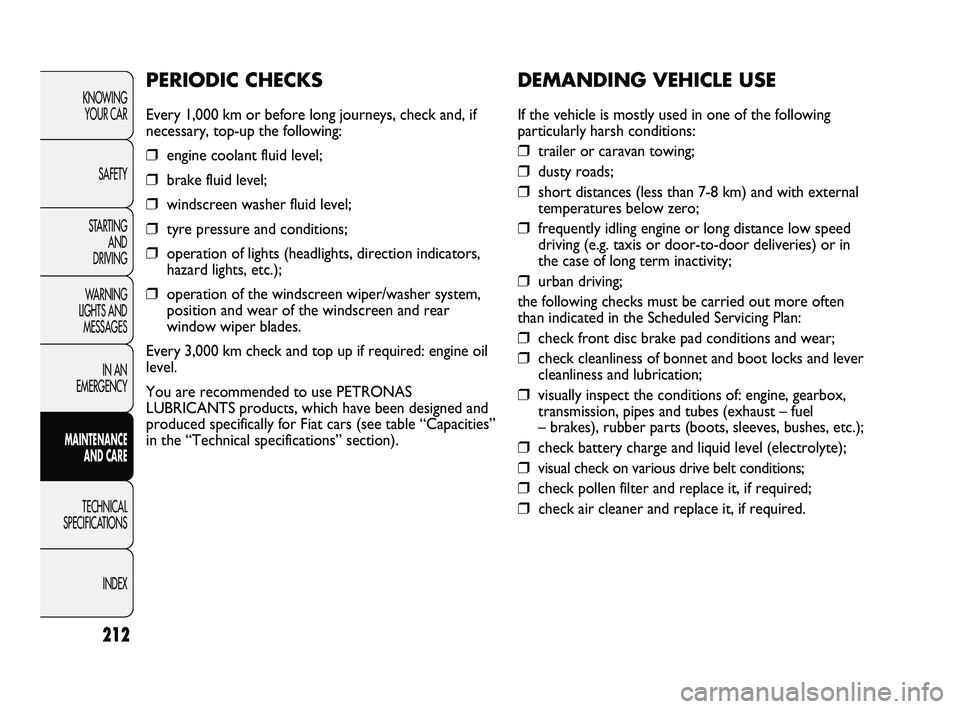
212
KNOWING
YOUR CAR
SAFETY
STARTING
AND
DRIVING
WARNING
LIGHTS AND
MESSAGES
IN AN
EMERGENCY
MAINTENANCE
AND CARE
TECHNICAL
SPECIFICATIONS
INDEX
DEMANDING VEHICLE USE
If the vehicle is mostly used in one of the following
particularly harsh conditions:
❒trailer or caravan towing;
❒dusty roads;
❒short distances (less than 7-8 km) and with external
temperatures below zero;
❒frequently idling engine or long distance low speed
driving (e.g. taxis or door-to-door deliveries) or in
the case of long term inactivity;
❒urban driving;
the following checks must be carried out more often
than indicated in the Scheduled Servicing Plan:
❒check front disc brake pad conditions and wear;
❒check cleanliness of bonnet and boot locks and lever
cleanliness and lubrication;
❒visually inspect the conditions of: engine, gearbox,
transmission, pipes and tubes (exhaust – fuel
– brakes), rubber parts (boots, sleeves, bushes, etc.);
❒check battery charge and liquid level (electrolyte);
❒visual check on various drive belt conditions;
❒check pollen filter and replace it, if required;
❒check air cleaner and replace it, if required.
PERIODIC CHECKS
Every 1,000 km or before long journeys, check and, if
necessary, top-up the following:
❒engine coolant fluid level;
❒brake fluid level;
❒windscreen washer fluid level;
❒tyre pressure and conditions;
❒operation of lights (headlights, direction indicators,
hazard lights, etc.);
❒operation of the windscreen wiper/washer system,
position and wear of the windscreen and rear
window wiper blades.
Every 3,000 km check and top up if required: engine oil
level.
You are recommended to use PETRONAS
LUBRICANTS products, which have been designed and
produced specifically for Fiat cars (see table “Capacities”
in the “Technical specifications” section).
207-230 DUCATO LUM EN 7ed 6/21/10 2:17 PM Page 212